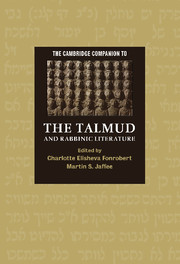Book contents
- Frontmatter
- Introduction: The Talmud, Rabbinic Literature, and Jewish Culture
- Part I: The Conditions of Rabbinic Literary Activity
- Part II: The Genres of Rabbinic Literary Composition
- 5 Rabbinic Midrash and Ancient Jewish Biblical Interpretation
- 6 The Judaean Legal Tradition and the Halakhah of the Mishnah
- 7 Roman Law and Rabbinic Legal Composition
- 8 Middle Persian Culture and Babylonian Sages: Accommodation and Resistance in the Shaping of Rabbinic Legal Tradition
- 9 Jewish Visionary Tradition in Rabbinic Literature
- 10 An Almost Invisible Presence: Multilingual Puns in Rabbinic Literature
- Part III: Hermeneutical Frames for Interpreting Rabbinic Literature
- Bibliography
- Index
- Source Index
- Series List
5 - Rabbinic Midrash and Ancient Jewish Biblical Interpretation
from Part II: - The Genres of Rabbinic Literary Composition
Published online by Cambridge University Press: 28 November 2007
- Frontmatter
- Introduction: The Talmud, Rabbinic Literature, and Jewish Culture
- Part I: The Conditions of Rabbinic Literary Activity
- Part II: The Genres of Rabbinic Literary Composition
- 5 Rabbinic Midrash and Ancient Jewish Biblical Interpretation
- 6 The Judaean Legal Tradition and the Halakhah of the Mishnah
- 7 Roman Law and Rabbinic Legal Composition
- 8 Middle Persian Culture and Babylonian Sages: Accommodation and Resistance in the Shaping of Rabbinic Legal Tradition
- 9 Jewish Visionary Tradition in Rabbinic Literature
- 10 An Almost Invisible Presence: Multilingual Puns in Rabbinic Literature
- Part III: Hermeneutical Frames for Interpreting Rabbinic Literature
- Bibliography
- Index
- Source Index
- Series List
Summary
In the last several decades, the quantity and variety of ancient Jewish literature that displays interpretive engagement with the Hebrew Bible has vastly increased, in large measure thanks to the ongoing publication of and scholarship on the Dead Sea Scrolls. While we might think of the Dead Sea Scrolls as representing the textual activity of a relatively small and short-lived sectarian community, the value of these discoveries have had much broader implications for the history of the texts of what was to become the Hebrew Bible and for their interpretation beyond the boundaries of this one community or movement and its time. The many biblical texts found among the Dead Sea Scrolls open a window onto the evolving state of scriptures in Jewish society more broadly, as does the discovery of many texts that would not find their way into the Jewish scriptural canon, yet which are not specifically “sectarian” and, therefore, can be assumed (and in some cases known) to have circulated much more broadly in Second Temple Jewish society and beyond. Thus, it is not just the quantity of texts of scriptural interpretation that has increased but the very parameters of what is understood to constitute the varieties of scriptural interpretation. Texts long known prior to the discovery of the Dead Sea Scrolls (generally transmitted through Christian channels and often in later Christian translations) are now appreciated as early works of Jewish scriptural interpretation, whereas previously, their value was thought to lie elsewhere (as history, philosophy, eschatology, etc.). In effect, a scholarly field of study of biblical interpretation has been created where either none previously existed or it only existed in the shadows of other scholarly preoccupations.
- Type
- Chapter
- Information
- Publisher: Cambridge University PressPrint publication year: 2007
- 5
- Cited by

